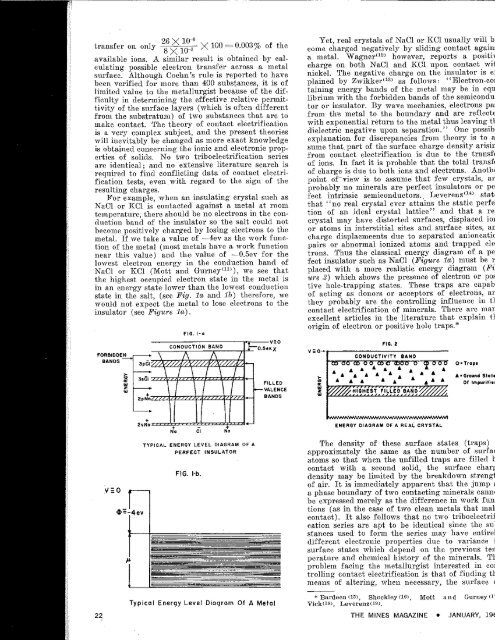1 - Mines Magazine - Colorado School of Mines
1 - Mines Magazine - Colorado School of Mines
1 - Mines Magazine - Colorado School of Mines
- No tags were found...
You also want an ePaper? Increase the reach of your titles
YUMPU automatically turns print PDFs into web optimized ePapers that Google loves.
transfer on only ^^^zr" X 100 = 0.003% <strong>of</strong> tlicavailable ions. A similar result is obtained by calculatingpossible electron transfer across a metalsurface. Altbougli Coehn's rule is reported to havebeen verified for more than 400 substances, it is <strong>of</strong>limited value to the metallurgist beca.use <strong>of</strong> the difficultyin determining the effective relative permittivity<strong>of</strong> the surfa.ce la.yers (which is <strong>of</strong>ten differentfrom thc substratum) <strong>of</strong> two substances that are tomake contact. The theory <strong>of</strong> contact electrificationis a very complex subject, aud the present theorieswill mevitably be changed as more exact knowledgeis obtained concerning the ionic and electronic properties<strong>of</strong> solids. No two triboelectrification seriesarc identical; and no extensive literature search isrequired to find conflicting data <strong>of</strong> contact electrificationtests, even,with rega.rd to the sign <strong>of</strong> theresulting charges.For example, when an insulating crystal siich asNaCl or KCl is contacted against a metal at roomtemperature, there should be no electrons in the conductionband <strong>of</strong> the iusulator so the salt could notbecome positively charged by losing electrons to themetal. If wc take a value <strong>of</strong> —4ev as the work fmietion<strong>of</strong> the metai (most metals have a work functionnear this vahie) and the value <strong>of</strong> —0.5ev for thelowest electron energy in the conduction band <strong>of</strong>NaCl or KCl (Mott and Gurney'"'), we see thatthe highest occupied electron state in the metal isin an energy state lower than the lowest conductionstate iu the salt, (sec Fig. la and Ih) therefore, wewould not expect the metal to lose electrons to theinsulator (see Figure la).FORBtODEN_22BANDSV = 0*=-4evFIG, 1-0TYPICAL ENERGY LEVEL DIAGRAM OF APERFECTFIG. l-b.INSULAtORTypical Energy Level Diogrom Of A MetalYet, real crystals <strong>of</strong> NaCl or KCl usually will hecomecharged negatively hy sliding contact againsta metal. "Wagner'^^* however, reports a positivecharge on both NaCl and KCl, upon contact withnickel. The negative charge on the insulator is explainedby Zwikker points out that local heating is also an importanteffect in electrification due to ion transfer.t Leverenz(20) ascribes tlie trapping <strong>of</strong> X-ray-excited electronsin KCl crystals to sites <strong>of</strong> missing or displaced CIions in the crystals.FIG. 3EFFECT OF HEAT TREATMENT ON ELECTRiCALSEPARATION OF SYLVINITE ORE» to M> 40 90 to ro ao 90 loo% N.O nCOVMT IN CONCENTRATE300 SOO TOO 900PREHEATTEHPEHATUitE.'F.In some cases it is also possible to alter thc surface<strong>of</strong> one <strong>of</strong> the mineral species in the ore by selectivereagentizing or other chemical treatmentusing methods similar to those in froth flotation.In many simple cases it is only necessary to havediscrete surfaces in order to obtain suitable pai'ticleparticiecontact electrification. The treatment isthen simplified to that <strong>of</strong> desliming (removal <strong>of</strong> acommon surface from the mineral species in the ore).Por example, Florida quartz contacted against Floridaphosphate rock will charge the quartz highlynegatively and the phosphate rock equally positivelyover a temperature range from about —40° C to300° C. Sea sand contacted against silica gel willcause the quartz to he positively charged and thesilica gel negatively charged (at 30° C).FIG. 5TYPICAL ELECTRICAL SEPARATION OF FLA.PHOSPHATE ROCK USING PARTICLE-PARTSCLECONTACT ELECTRIFICATION CHARGING MECHANISM1004050 60 70 aO 90 100V. RECOVERY OF PHOSPHATE MINERAL IN CONCENTRATEFigure 5 shows the mineral distribution <strong>of</strong> asingle pass for a separation <strong>of</strong> quartz from Plroidaphosphate rock at a temperature <strong>of</strong> 150° C. TheTHE MINES MAGAZiNE • JANUARY, 1960 23
















